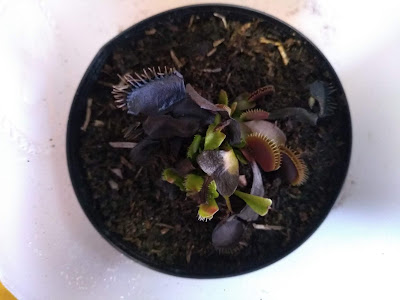Woolly Kate tomato is not an F1 hybrid, it is not GM, it is a stable variety that was conventionally bred, open pollinated, and is simple to save seed from each year to be able to grow it again in the future.
Woolly Kate carries the woolly allele that causes the leaves, stems, and fruits to be covered in fuzz. It also has black/blue fruit wherever the sun hits it and is yellow underneath and yellow anywhere the sun does not hit.
This is an indeterminate tomato plant, and it appears to be dwarf. I like dwarf indeterminate tomatoes. They have all the benefits of indeterminate tomatoes while staying relatively small.
All in all Woolly Kate tomato has a lot of interesting genes!
 |
| Woolly Kate tomato - black where the sun hits the fruit and yellow underneath |
 |
| Woolly Kate tomato - look how black they get in full sun |
Most of the high anthocyanin tomatoes are red underneath, meaning that they look incredible when not ripe but as they ripen the red starts to show through and they don't look as amazing. Woolly Kate is yellow instead of red, meaning that when it is ripe it still looks pretty amazing ad the colours are intense.
Anthocyanin is a dark antioxidant, it is the same one that is found in blueberries. As Woolly Kate is high in anthocyanin it is very healthy for you.
 |
| Woolly Kate - you can see where this one was shaded |
In the right light the plant shimmers and shines. The leaves look amazing, and they feel incredibly soft. When walking past I can't help but to touch these soft leaves. My kids also can't help but to touch the soft leaves.
 |
| Woolly tomato leaves look incredible |
I am not sure if this fuzzy foliage would cause increased issues with tiny insects or if it would deter them, I don't really have problems with mites here so can't really comment either way.
I am told that the hairs reflect the heat and help this plant to be more water wise and to cope better in extreme heat. To be completely honest I am not sure if this is true or not. What I do know is that this summer when many of my plants failed in the heat/dry/smoke Woolly Kate powered through and fruited well.
I am also told that the hairs can help protect against mild frosts. I highly doubt this claim but we will see what happens as winter approaches.
 |
| The stems and leaves are quite fuzzy |
Eventually the green parts of the fruit ripen and turn yellow. I have never seen anything like it. This tomato has been a real conversation starter with everyone who has seen it in my garden.
 |
| The fruit is black or blue where the sun hits them |
 |
| Woolly Kate unripe fruits getting dark in the sun |
 |
| The leaves are very fluffy |
 |
| They turn black where sunlight hits them |
 |
| Unripe fruit |
 |
| The leaves are very fluffy |
At first I was not sure if fuzzy tomatoes would be nice to eat raw. Even though the fruits of Woolly Kate are fuzzy it isn't bad. It is a soft fuzz, similar to a peach, and doesn't feel bad in your mouth.
 |
| The fruit is covered in soft peach like fuzz |
I hope to have some extra seed and be able to offer it for sale. When this happens they will be listed on my for sale page. Like all of my tomatoes and other vegetables, I grow them completely organically.








































